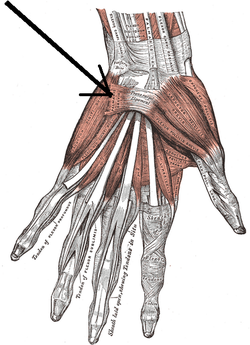|
Palmaris brevis muscle
Palmaris brevis muscle is a thin, quadrilateral muscle, placed beneath the integument of the ulnar side of the hand. It acts to fold the skin of the hypothenar eminence transversally. StructureOrigin and insertionPalmaris brevis muscle is located on the ulnar side of the hand.[1][2] It arises from the tendinous fasciculi from the transverse carpal ligament and palmar aponeurosis. The muscle fibres are inserted into the skin on the ulnar border of the palm of the hand,[1] and occasionally on the pisiform bone.[3] InnervationPalmaris brevis muscle is the only muscle innervated by the superficial branch of the ulnar nerve (C8, T1).[2] Blood supplyPalmaris brevis muscle is supplied by the palmar metacarpal artery of the deep palmar arch. DiscoveryThe first recorded observation of the muscle is by Italian anatomist Giambattista Canano sometime before 1543. The muscle was independently discovered a few years later by Realdo Colombo before being pushed to general acceptance in the works of Andreas Vesalius.[4] FunctionPalmaris brevis muscle tenses the skin of the palm on the ulnar side during a grip action.[2][3] It also deepens the hollow of the palm.[5] The palmaris brevis may protect the ulnar nerve and ulnar artery from compressive forces during repetitive grasping actions.[6] The muscle has a fatigue-resistant fiber type profile, which supports the idea of a protective function to the ulnar neurovasculature during repetitive intermittent grasping tasks.[7] See alsoAdditional imagesReferences
|
||||||||||||||||||||||||||||

